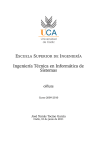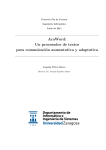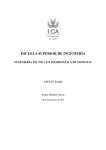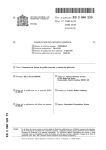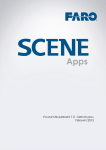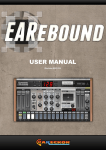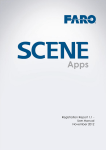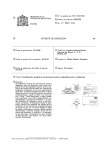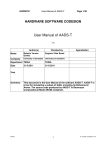Download Ingenier´ıa Técnica en Informática de Sistemas
Transcript
E SCUELA S UPERIOR DE I NGENIER ÍA Ingenierı́a Técnica en Informática de Sistemas oFlute Curso 2009-2010 José Tomás Tocino Garcı́a Cádiz, 7 de septiembre de 2010 E SCUELA S UPERIOR DE I NGENIER ÍA Ingenierı́a Técnica en Informática de Sistemas oFlute D EPARTAMENTO: Lenguajes y Sistemas Informáticos. D IRECTOR DEL PROYECTO: Manuel Palomo Duarte. AUTOR DEL P ROYECTO: José Tomás Tocino Garcı́a. Cádiz, 7 de septiembre de 2010 Fdo.: José Tomás Tocino Garcı́a Este documento se halla bajo la licencia FDL (Free Documentation License). Según estipula la licencia, se muestra aquı́ el aviso de copyright. Se ha usado la versión inglesa de la licencia, al ser la única reconocida oficialmente por la FSF (Free Software Foundation). c Copyright 2010 José Tomás Tocino Garcı́a. Permission is granted to copy, distribute and/or modify this document under the terms of the GNU Free Documentation License, Version 1.2 or any later version published by the Free Software Foundation; with no Invariant Sections, no Front-Cover Texts, and no Back-Cover Texts. A copy of the license is included in the section entitled ”GNU Free Documentation License”. 5 Agradecimientos A Julian Raschke por crear y mantener Gosu. 7 Índice general Índice general 9 Índice de figuras 11 Índice de cuadros 13 1. Introducción 15 1.1. Contexto y motivación . . . . . . 1.2. Objetivos . . . . . . . . . . . . . 1.2.1. Funcionales . . . . . . . . 1.2.2. Transversales . . . . . . . 1.3. Alcance . . . . . . . . . . . . . . 1.3.1. Limitaciones del proyecto 1.3.2. Licencia . . . . . . . . . . 1.4. Visión general . . . . . . . . . . . 1.5. Glosario . . . . . . . . . . . . . . 1.5.1. Acrónimos . . . . . . . . . 1.5.2. Definiciones . . . . . . . . . . . . . . . . . . . . . . . . . . . . . . . . . . . . . . . . . . . . . . . . . . . . . . . . . . . . . . . . . . . . . . . . . . . . . . . . . . . . . . . . . . . . . . . . . . . . . . . . . . . . . . . . . . . . . . . . . . . . . . . . . . . . . . . . . . . . . . . . . . . . . . . . . . . . . . . . . . . . . . . . . . . . . . . . . . . . . . . . . . . . . . . . . . . . . . . . . . . . . . . . . . . . . . . . . . . . . . . . . . . . . . . . . . . . . . . . . . . . . . . . . . 15 15 15 16 16 17 17 18 18 18 18 2.1. El sonido . . . . . . . . . . . . . . . . . . . . . . . 2.1.1. Frecuencia y tono . . . . . . . . . . . . . . . 2.1.2. Amplitud . . . . . . . . . . . . . . . . . . . 2.1.3. Fase . . . . . . . . . . . . . . . . . . . . . . 2.2. Descomposición de sonidos . . . . . . . . . . . . . 2.2.1. Representación gráfica de sonidos . . . . . . 2.2.2. Herramientas de descomposición de señales . . . . . . . . . . . . . . . . . . . . . . . . . . . . . . . . . . . . . . . . . . . . . . . . . . . . . . . . . . . . . . . . . . . . . . . . . . . . . . . . . . . . 19 19 20 20 20 21 22 2. Conceptos básicos 19 3. Desarrollo del calendario 3.1. Iteraciones . . . . . . . . . . . . . . . . . . . . . . . 3.1.1. Primera iteración: conocimientos preliminares 3.1.2. Segunda iteración: analizador básico . . . . . 3.1.3. Tercera iteración: interfaz gráfica de usuario . 3.1.4. Cuarta iteración: motor de lecciones . . . . . 3.1.5. Quinta iteración: motor de canciones . . . . . 3.2. Diagrama de Gantt . . . . . . . . . . . . . . . . . . . 3.3. Porcentajes de esfuerzo . . . . . . . . . . . . . . . . 23 . . . . . . . . . . . . . . . . . . . . . . . . . . . . . . . . . . . . . . . . . . . . . . . . . . . . . . . . . . . . . . . . . . . . . . . . . . . . . . . . . . . . . . . . 23 23 23 24 24 24 24 24 9 ÍNDICE GENERAL 4. Descripción general del proyecto 4.1. 4.2. 4.3. 4.4. 4.5. 4.6. Perspectiva del producto . . . . . Funciones . . . . . . . . . . . . . Caracterı́sticas de los usuarios . . Restricciones generales . . . . . . Suposiciones y dependencias . . Requisitos para futuras versiones 25 . . . . . . . . . . . . . . . . . . . . . . . . . . . . . . . . . . . . . . . . . . . . . . . . . . . . . . . . . . . . . . . . . . . . . . . . . . . . . . . . . . . . . . . . . . . . . . . . . . . . . . . . . . . . . . . . . . . . . . . . . . . . . . . . . . . . 25 25 25 25 25 25 5. Desarrollo del proyecto 27 6. Resumen 29 7. Conclusiones 31 8. Manual del usuario 33 9. Guı́a de ampliación 35 A. GNU Free Documentation License 37 1. APPLICABILITY AND DEFINITIONS . . . . . . 2. VERBATIM COPYING . . . . . . . . . . . . . . 3. COPYING IN QUANTITY . . . . . . . . . . . . 4. MODIFICATIONS . . . . . . . . . . . . . . . . 5. COMBINING DOCUMENTS . . . . . . . . . . . 6. COLLECTIONS OF DOCUMENTS . . . . . . . . 7. AGGREGATION WITH INDEPENDENT WORKS 8. TRANSLATION . . . . . . . . . . . . . . . . . . 9. TERMINATION . . . . . . . . . . . . . . . . . . 10. FUTURE REVISIONS OF THIS LICENSE . . . Bibliografı́a 10 . . . . . . . . . . . . . . . . . . . . . . . . . . . . . . . . . . . . . . . . . . . . . . . . . . . . . . . . . . . . . . . . . . . . . . . . . . . . . . . . . . . . . . . . . . . . . . . . . . . . . . . . . . . . . . . . . . . . . . . . . . . . . . . . . . . . . . . . . . . . . . . . . . . . . . . . . . . . . . . . 37 39 39 40 42 42 43 43 43 44 45 Índice de figuras 2.1. Rango de frecuencias de sonido . . . . . . . . . . . . . . . . . . . . . . . 20 2.2. Componentes de una señal senoidal básica . . . . . . . . . . . . . . . . . 20 2.3. Forma de ondas vs representación espectral . . . . . . . . . . . . . . . . 21 11 Índice de cuadros 13 1. Introducción 1.1. Contexto y motivación Las nuevas tecnologı́as van filtrándose gradualmente en los centros educativos, y las técnicas de enseñanza se están adaptando a las opciones que ofrecen. El reparto de ordenadores portátiles a los alumnos andaluces de 5o y 6o de primaria, dentro del marco de la Escuela TIC 2.0, es buena muestra de ello. Por otro lado, las nuevas generaciones están en plena simbiosis con las tecnologı́as de la información, cada vez más acostumbradas al empleo de dispositivos electrónicos, y su uso ya les es prácticamente instintivo. Por tanto, es beneficioso buscar nuevos métodos educativos que hagan uso de las nuevas tecnologı́as. En la búsqueda de materias educativas en las que aplicar el uso de las nuevas tecnologı́as, la música, parte fundamental del programa curricular en la educación primaria, ofrece una gran variedad de aspectos que podrı́an desarrollarse utilizando tecnologı́as de la información. Es ahı́ donde este proyecto hace su aportación. 1.2. Objetivos A la hora de definir los objetivos de un sistema, podemos agruparlos en dos tipos diferentes: funcionales y transversales. Los primeros se refieren a qué debe hacer la aplicación que vamos a desarrollar, e inciden directamente en la experiencia del usuario y de potenciales desarrolladores. Por otro lado, los objetivos transversales son aquellos invisibles al usuario final, pero que de forma inherente actúan sobre el resultado final de la aplicación y sobre la experiencia de desarrollo de la misma. 1.2.1. Funcionales Crear un módulo de análisis del sonido en el dominio de la frecuencia para poder identificar las notas capturadas por el micrófono en tiempo real. 15 1. Introducción Crear una aplicación de usuario que identifique y muestre en pantalla las notas que toca el usuario en cada momento. Reutilizar el módulo de análisis en un juego en el que el usuario debe tocar correctamente las nota que aparecen en pantalla siguiendo un pentagrama. Incluir un sistema de lecciones multimedia individuales que sirvan al alumno de referencia y fuente de aprendizaje. Potenciar el uso de interfaces de usuario amigables, con un sistema avanzado de animaciones que proporcione un aspecto fluido y evite saltos bruscos entre secciones. 1.2.2. Transversales Obtener una base teórica sobre cómo se representa y caracteriza digitalmente el sonido. Conocer las bases del DSP (Digital Signal Processing), y su uso en aplicaciones de reconocimiento básico de sonidos, tales como sintonizadores y afinadores de instrumentos. Introducirme en la programación de audio en sistemas GNU/Linux. Entender las bases del análisis de sonidos en el dominio de la frecuencia. Utilizar un enfoque de análisis, diseño y codificación orientado a objetos, de una forma lo más clara y modular posible, para permitir ampliaciones y modificaciones sobre la aplicación por terceras personas. Hacer uso de herramientas básicas en el desarrollo de software, como son los Sistemas de Control de Versiones para llevar un control realista del desarrollo del software, ası́ como hacer de las veces de sistema de copias de seguridad. 1.3. Alcance oFlute se modela como una herramienta lúdico-educativa para alumnos que comiencen a aprender a usar la flauta dulce, proporcionando un entorno atractivo y ameno para el estudiante. Éstos tendrán la posibilidad de recorrer una serie de pequeñas lecciones sobre música en general, y el uso de la flauta dulce en particular. Además, el usuario tendrá la posibilidad de comprobar sus conocimientos sobre el uso de la flauta practicando, gracias a las secciones de análisis de notas y de canciones, en las que la aplicación valorará la pericia del estudiante con la flauta. 16 1.3. Alcance 1.3.1. Limitaciones del proyecto El proyecto se limita al uso de la flauta dulce y no a otros instrumentos por la enorme variabilidad de timbre entre ellos, lo que supondrı́a un enorme esfuerzo a la hora de generalizar el analizador de frecuencias. El sistema de lecciones se basa en plantillas XML en las que es posible definir imágenes y texto para formar una pantalla de información. En un futuro se ampliará para incluir otros elementos multimedia ası́ como lecciones con varias pantallas consecutivas. Los sistemas de audio son una de las áreas en las que menos consenso hay entre plataformas informáticas, por lo que la portabilidad de las aplicaciones suele ser compleja. El presente proyecto utiliza la API Simple de PulseAudio como subsistema de sonido, que es en teorı́a compatible con plataformas Win32, pero en la práctica su complejidad hace prácticamente inviable la portabilidad de la aplicación. 1.3.2. Licencia El proyecto está publicado como software libre bajo la licencia GPL (General Public License) versión 2. El conjunto de bibliotecas y módulos utilizados tienen las siguientes licencias: Gosu [6], la biblioteca de desarrollo de videojuegos que ha proporcionado el subsistema gráfico, utiliza la licencia MIT (Massachusetts Institute of Technology). Cuando se compila en sistemas Windows, utiliza la biblioteca FMOD que es gratuita pero de código cerrado; en sistemas GNU/Linux, utiliza SDL mixer, que utiliza la licencia LGPL (Lesser General Public License). Kiss FFT [4], la biblioteca utilizada para hacer el análisis de frecuencias, utiliza una licencia BSD (Berkeley Software Distribution). PugiXML [5], biblioteca de procesamiento de ficheros XML, se distribuye bajo al licencia MIT. A lo largo del proyecto se utilizan diferentes partes de las bibliotecas Boost [1], que utilizan la licencia Boost Software License 1 . Se trata de una licencia de software libre, compatible con la GPL, y comparable en permisividad a las licencias BSD y MIT. PulseAudio [3] utiliza una licencia LGPL 2.1. 1 http://www.boost.org/LICENSE_1_0.txt 17 1. Introducción 1.4. Visión general Tras una revisión del calendario seguido, detallaremos a lo largo del resto de la memoria el proceso de análisis, diseño, codificación y pruebas que se siguió al realizar el proyecto. Los manuales de usuario y de instalación se incluyen tras un resumen de los aspectos más destacables de proyecto y las conclusiones. En dicho manual, se hallan dos apartados dirigidos a la ampliación de la aplicación mediante la creación de nuevas lecciones y de nuevas canciones, respectivamente. 1.5. Glosario 1.5.1. Acrónimos BSD Berkeley Software Distribution DSP Digital Signal Processing FDL Free Documentation License FFT Fast Fourier Transform FSF Free Software Foundation GPL General Public License LGPL Lesser General Public License MIT Massachusetts Institute of Technology 1.5.2. Definiciones Timbre Cualidad de un sonido que permite distinguir la misma nota producida por dos instrumentos musicales u orı́genes diferentes. 18 2. Conceptos básicos Para poder enfrentarnos con garantı́as al desarrollo del proyecto es necesario conocer una serie de conceptos relacionados con el sonido y la música en general, y conceptos sobre análisis de señales que explicaremos a lo largo de este capı́tulo. 2.1. El sonido Un sonido es una vibración que se propaga por un medio elástico en forma de onda. Estas vibraciones se transmiten de forma longitudinal, esto es, en la misma dirección en la que se propaga la onda. El medio más común para la transmisión del sonido es el aire. El sonido, en su forma más simple, se compone de una sola onda sinusoidal básica, con las caracterı́sticas tradicionales: amplitud, frecuencia y fase. Una onda sinusoidal es aquella cuyos valores se calculan utilizando funciones seno. 2.1.1. Frecuencia y tono La frecuencia mide el número de oscilaciones de la onda por unidad de tiempo. Por regla general, se utiliza el hercio como unidad de medida de frecuencia, que indica la cantidad de repeticiones por segundo. La frecuencia determinará la altura del sonido, es decir, cómo de grave o agudo es. Los sonidos graves tienen una frecuencia baja, mientras que los sonidos agudos tienen una frecuencia alta. A lo largo de los años se ha establecido un estándar de referencia que establece que la nota la que se encuentra encima del do central del piano debe sonar a 440 hercios de frecuencia. Esta medida se utiliza a la hora de afinar los instrumentos, de modo que si al tocar la nota la se detecta un tono con una frecuencia de 440 hercios, entonces el instrumento estará bien afinado. El espectro audible por las personas lo conforman las audiofrecuencias, esto es, el conjunto de frecuencias que pueden ser percibidas por el oı́do humano. Un oı́do sano y joven es capaz de detectar sonidos a partir de los 20 hercios. Los sonidos por debajo de esa frecuencia se conocen como infrasonidos. Por otro lado, el lı́mite auditivo en frecuencias altas varı́a mucho con la edad: un adolescente puede oir 19 2. Conceptos básicos 20Hz Infrasonido 20kHz Audible Ultrasonido Figura 2.1.: Rango de frecuencias de sonido sonidos con frecuencias hasta los 18kHz, mientras que un adulto de edad media solo suele llegar a captar sonidos de hasta 13kHz. El lı́mite genérico superior se establece en 20kHz, por encima de los cuales los sonidos se denominan ultrasonidos. 2.1.2. Amplitud La amplitud representa la energı́a que transporta la onda. Cuando un instrumento u otro objeto genera una vibración, la amplitud es la cantidad de movimiento que esa vibración genera. Podrı́a equipararse (de forma no estricta) a la intensidad del sonido: cuanto mayor sea la amplitud, más fuerte se oirá el sonido. 2.1.3. Fase Por último, la fase (ϕ) indica el desplazamiento horizontal de la onda respecto del origen. Si la fase de una onda no es cero, entonces parecerá que está desplazada hacia la derecha, si la fase es positiva, y hacia la izquierda si la fase es negativa. x(t) Amplitud φ 1/frecuencia t Figura 2.2.: Componentes de una señal senoidal básica 2.2. Descomposición de sonidos Para desarrollar oFlute nos interesa conocer la altura de la nota que está tocando la flauta en un instante concreto. Para un tono puro, podrı́amos conocer la altura fijándonos en su frecuencia. El problema es que, en la naturaleza, no existen los tonos puros, sino que los sonidos se componen de multitud de tonos de diferentes amplitudes, frecuencias y fases. 20 2.2. Descomposición de sonidos Afortunadamente, la teorı́a dicta que cualquier tono complejo puede descomponerse como suma de tonos puros de distintas amplitudes, fases y frecuencias, llamados parciales. La menor de todas las frecuencias de los parciales se conoce como frecuencia fundamental, y es la que que dicta la altura general del sonido – general, ya que aunque el resto de frecuencias puede corresponder a otras notas, es la altura de la frecuencia fundamental la que mayor relevancia tiene en el sonido. Un subconjunto de esos parciales, conocidos como armónicos, tienen frecuencias múltiplos de la frecuencia fundamental. Estos armónicos sirven para enriquecer el sonido y, sobre todo, determinar el timbre musical del origen del sonido: dos instrumentos (o personas) pueden estar tocando la misma nota y emitir la misma frecuencia fundamental, pero será el conjunto total de armónicos el que nos ayude a distinguir qué instrumento está emitiendo el sonido. Ası́ pues, el objetivo es encontrar una forma de descomponer una señal (el sonido) en sus componentes y analizar sus frecuencias, buscando la frecuencia fundamental, que nos informará de la nota que se está tocando. 2.2.1. Representación gráfica de sonidos Las representación habitual de las señales se hace en el dominio del tiempo, es decir, podemos observar cómo la señal cambia a lo largo del tiempo, viendo el valor de su amplitud en cada instante. Por otro lado, la representación en el dominio de la frecuencia nos permite analizar una señal respecto a las frecuencias que la componen, dividiendo la señal en sus componentes. En la figura 2.3 podemos comparar la representación de un sonido en el dominio del tiempo, en forma de ondas, tal y como aparecerı́a en un osciloscopio, frente a su representación en forma espectral, en la que el eje vertical indica la frecuencia, y la intensidad del color indica la intensidad de esa componente frecuencial en el sonido. Figura 2.3.: Forma de ondas vs representación espectral 21 2. Conceptos básicos 2.2.2. Herramientas de descomposición de señales La herramienta fundamental a la hora de descomponer una señal periódica como puede ser un sonido en sus parciales o armónicos es el análisis armónico o análisis de Fourier. Esta rama del análisis matemático estudia la representación de funciones o señales como superposición de ondas básicas, y hoy en dı́a se aplica en innumerables campos de la ciencia, desde el procesamiento de señales, como es nuestro caso, a la neurociencia. Una de las herramientas más conocidas de este área es la transformada de Fourier, que nos permite pasar una señal del dominio del tiempo al de la frecuencia. La transformada de Fourier es una aplicación matemática 22 3. Desarrollo del calendario El proyecto no se ha desarrollado siguiendo un calendario estricto, dado que era imposible cuantificar el tiempo que tomarı́a el adquirir las bases teóricas necesarias para poder afrontarlo con garantı́as. Su desarrollo se ha compaginado con los estudios del último curso de Ingenierı́a Técnica en Informática de Sistemas y las labores como becario en la Oficina de Software Libre y Conocimiento Abierto de la Universidad de Cádiz [2]. 3.1. Iteraciones Para la realización del proyecto se ha utilizado un modelo de desarrollo iterativo incremental. A continuación se detallan cada una e las etapas por las que ha ido pasando el proyecto. 3.1.1. Primera iteración: conocimientos preliminares Antes de poder comenzar con el análisis y diseño del propio proyecto, era esencial adquirir una serie de conocimientos para poder afrontar su desarrollo con todas las garantı́as. Durante esta iteración, se llevaron a cabo labores de documentación y aprendizaje autodidacta con las que se asentaron los conocimientos necesarios. Además, durante este periodo también se barajaron las diferentes posibilidades de implementación del sistema, ası́ como las posibles herramientas y bibliotecas de terceros que pudieran ser de ayuda. 3.1.2. Segunda iteración: analizador básico Una vez adquiridos los conocimientos teóricos necesarios, y decididas las técnicas y herramientas para llevar aquellos a la práctica, fue obvia la necesidad de empezar por diseñar un analizador de notas básico, que serı́a el corazón del programa. Del éxito del desarrollo temprano del módulo que se encargarı́a del análisis de sonidos dependerı́a la viabilidad completa del proyecto. 23 3. Desarrollo del calendario 3.1.3. Tercera iteración: interfaz gráfica de usuario Con el módulo de análisis desarrollado, sólo restaba desarrollar el resto de la aplicación alrededor del mismo. En esta tercera iteración se propusieron numerosos diseños para la interfaz gráfica de usuario y, una vez decantados por uno de ellos, comenzó el desarrollo de los elementos de la interfaz, haciendo énfasis en conseguir un aspecto dinámico y jovial. 3.1.4. Cuarta iteración: motor de lecciones Uno de los subproductos de la aplicación es el motor de lecciones, que presenta una serie de unidades didácticas en formato multimedia, compuestas de imágenes y textos, con conceptos sobre música. En esta iteración se hizo un análisis de las posibilidades de este motor, concluyendo con el diseño y desarrollo de un mecanismo muy sencillo de ampliar y utilizar. 3.1.5. Quinta iteración: motor de canciones La parte de mayor interactividad de la aplicación es el motor de canciones, en el que el usuario tiene la posibilidad de tocar una canción que aparece en pantalla, usando la flauta, mientras la aplicación valora en tiempo real su interpretación. Durante la quinta iteración se elaboró este sistema, encargado de listar y cargar las diferentes canciones, y puntuar al usuario según cómo lo haga. 3.2. Diagrama de Gantt 3.3. Porcentajes de esfuerzo por hacer 24 4. Descripción general del proyecto 4.1. Perspectiva del producto 4.2. Funciones Lista de funciones 4.3. Caracterı́sticas de los usuarios 4.4. Restricciones generales 4.5. Suposiciones y dependencias 4.6. Requisitos para futuras versiones 25 5. Desarrollo del proyecto Blablablá 27 6. Resumen 29 7. Conclusiones 31 8. Manual del usuario 33 9. Guı́a de ampliación 35 A. GNU Free Documentation License Version 1.2, November 2002 c Copyright 2000,2001,2002 Free Software Foundation, Inc. 51 Franklin St, Fifth Floor, Boston, MA 02110-1301 USA Everyone is permitted to copy and distribute verbatim copies of this license document, but changing it is not allowed. Preamble The purpose of this License is to make a manual, textbook, or other functional and useful document “free” in the sense of freedom: to assure everyone the effective freedom to copy and redistribute it, with or without modifying it, either commercially or noncommercially. Secondarily, this License preserves for the author and publisher a way to get credit for their work, while not being considered responsible for modifications made by others. This License is a kind of “copyleft”, which means that derivative works of the document must themselves be free in the same sense. It complements the GNU General Public License, which is a copyleft license designed for free software. We have designed this License in order to use it for manuals for free software, because free software needs free documentation: a free program should come with manuals providing the same freedoms that the software does. But this License is not limited to software manuals; it can be used for any textual work, regardless of subject matter or whether it is published as a printed book. We recommend this License principally for works whose purpose is instruction or reference. 1. APPLICABILITY AND DEFINITIONS This License applies to any manual or other work, in any medium, that contains a notice placed by the copyright holder saying it can be distributed under the terms of this License. Such a notice grants a world-wide, royalty-free license, unlimited in duration, to use that work under the conditions stated herein. The “Document”, below, 37 A. GNU Free Documentation License refers to any such manual or work. Any member of the public is a licensee, and is addressed as “you”. You accept the license if you copy, modify or distribute the work in a way requiring permission under copyright law. A “Modified Version” of the Document means any work containing the Document or a portion of it, either copied verbatim, or with modifications and/or translated into another language. A “Secondary Section” is a named appendix or a front-matter section of the Document that deals exclusively with the relationship of the publishers or authors of the Document to the Document’s overall subject (or to related matters) and contains nothing that could fall directly within that overall subject. (Thus, if the Document is in part a textbook of mathematics, a Secondary Section may not explain any mathematics.) The relationship could be a matter of historical connection with the subject or with related matters, or of legal, commercial, philosophical, ethical or political position regarding them. The “Invariant Sections” are certain Secondary Sections whose titles are designated, as being those of Invariant Sections, in the notice that says that the Document is released under this License. If a section does not fit the above definition of Secondary then it is not allowed to be designated as Invariant. The Document may contain zero Invariant Sections. If the Document does not identify any Invariant Sections then there are none. The “Cover Texts” are certain short passages of text that are listed, as Front-Cover Texts or Back-Cover Texts, in the notice that says that the Document is released under this License. A Front-Cover Text may be at most 5 words, and a Back-Cover Text may be at most 25 words. A “Transparent” copy of the Document means a machine-readable copy, represented in a format whose specification is available to the general public, that is suitable for revising the document straightforwardly with generic text editors or (for images composed of pixels) generic paint programs or (for drawings) some widely available drawing editor, and that is suitable for input to text formatters or for automatic translation to a variety of formats suitable for input to text formatters. A copy made in an otherwise Transparent file format whose markup, or absence of markup, has been arranged to thwart or discourage subsequent modification by readers is not Transparent. An image format is not Transparent if used for any substantial amount of text. A copy that is not “Transparent” is called “Opaque”. Examples of suitable formats for Transparent copies include plain ASCII without markup, Texinfo input format, LaTeX input format, SGML or XML using a publicly available DTD, and standard-conforming simple HTML, PostScript or PDF designed for human modification. Examples of transparent image formats include PNG, XCF and JPG. Opaque formats include proprietary formats that can be read and edited only by proprietary word processors, SGML or XML for which the DTD and/or processing 38 tools are not generally available, and the machine-generated HTML, PostScript or PDF produced by some word processors for output purposes only. The “Title Page” means, for a printed book, the title page itself, plus such following pages as are needed to hold, legibly, the material this License requires to appear in the title page. For works in formats which do not have any title page as such, “Title Page” means the text near the most prominent appearance of the work’s title, preceding the beginning of the body of the text. A section “Entitled XYZ” means a named subunit of the Document whose title either is precisely XYZ or contains XYZ in parentheses following text that translates XYZ in another language. (Here XYZ stands for a specific section name mentioned below, such as “Acknowledgements”, “Dedications”, “Endorsements”, or “History”.) To “Preserve the Title” of such a section when you modify the Document means that it remains a section “Entitled XYZ” according to this definition. The Document may include Warranty Disclaimers next to the notice which states that this License applies to the Document. These Warranty Disclaimers are considered to be included by reference in this License, but only as regards disclaiming warranties: any other implication that these Warranty Disclaimers may have is void and has no effect on the meaning of this License. 2. VERBATIM COPYING You may copy and distribute the Document in any medium, either commercially or noncommercially, provided that this License, the copyright notices, and the license notice saying this License applies to the Document are reproduced in all copies, and that you add no other conditions whatsoever to those of this License. You may not use technical measures to obstruct or control the reading or further copying of the copies you make or distribute. However, you may accept compensation in exchange for copies. If you distribute a large enough number of copies you must also follow the conditions in section 3. You may also lend copies, under the same conditions stated above, and you may publicly display copies. 3. COPYING IN QUANTITY If you publish printed copies (or copies in media that commonly have printed covers) of the Document, numbering more than 100, and the Document’s license notice requires Cover Texts, you must enclose the copies in covers that carry, clearly and legibly, all these Cover Texts: Front-Cover Texts on the front cover, and Back-Cover Texts on the back cover. Both covers must also clearly and legibly identify you as the publisher of these copies. The front cover must present the full title with all words of 39 A. GNU Free Documentation License the title equally prominent and visible. You may add other material on the covers in addition. Copying with changes limited to the covers, as long as they preserve the title of the Document and satisfy these conditions, can be treated as verbatim copying in other respects. If the required texts for either cover are too voluminous to fit legibly, you should put the first ones listed (as many as fit reasonably) on the actual cover, and continue the rest onto adjacent pages. If you publish or distribute Opaque copies of the Document numbering more than 100, you must either include a machine-readable Transparent copy along with each Opaque copy, or state in or with each Opaque copy a computer-network location from which the general network-using public has access to download using public-standard network protocols a complete Transparent copy of the Document, free of added material. If you use the latter option, you must take reasonably prudent steps, when you begin distribution of Opaque copies in quantity, to ensure that this Transparent copy will remain thus accessible at the stated location until at least one year after the last time you distribute an Opaque copy (directly or through your agents or retailers) of that edition to the public. It is requested, but not required, that you contact the authors of the Document well before redistributing any large number of copies, to give them a chance to provide you with an updated version of the Document. 4. MODIFICATIONS You may copy and distribute a Modified Version of the Document under the conditions of sections 2 and 3 above, provided that you release the Modified Version under precisely this License, with the Modified Version filling the role of the Document, thus licensing distribution and modification of the Modified Version to whoever possesses a copy of it. In addition, you must do these things in the Modified Version: A. Use in the Title Page (and on the covers, if any) a title distinct from that of the Document, and from those of previous versions (which should, if there were any, be listed in the History section of the Document). You may use the same title as a previous version if the original publisher of that version gives permission. B. List on the Title Page, as authors, one or more persons or entities responsible for authorship of the modifications in the Modified Version, together with at least five of the principal authors of the Document (all of its principal authors, if it has fewer than five), unless they release you from this requirement. C. State on the Title page the name of the publisher of the Modified Version, as the publisher. D. Preserve all the copyright notices of the Document. 40 E. Add an appropriate copyright notice for your modifications adjacent to the other copyright notices. F. Include, immediately after the copyright notices, a license notice giving the public permission to use the Modified Version under the terms of this License, in the form shown in the Addendum below. G. Preserve in that license notice the full lists of Invariant Sections and required Cover Texts given in the Document’s license notice. H. Include an unaltered copy of this License. I. Preserve the section Entitled “History”, Preserve its Title, and add to it an item stating at least the title, year, new authors, and publisher of the Modified Version as given on the Title Page. If there is no section Entitled “History” in the Document, create one stating the title, year, authors, and publisher of the Document as given on its Title Page, then add an item describing the Modified Version as stated in the previous sentence. J. Preserve the network location, if any, given in the Document for public access to a Transparent copy of the Document, and likewise the network locations given in the Document for previous versions it was based on. These may be placed in the “History” section. You may omit a network location for a work that was published at least four years before the Document itself, or if the original publisher of the version it refers to gives permission. K. For any section Entitled “Acknowledgements” or “Dedications”, Preserve the Title of the section, and preserve in the section all the substance and tone of each of the contributor acknowledgements and/or dedications given therein. L. Preserve all the Invariant Sections of the Document, unaltered in their text and in their titles. Section numbers or the equivalent are not considered part of the section titles. M. Delete any section Entitled “Endorsements”. Such a section may not be included in the Modified Version. N. Do not retitle any existing section to be Entitled “Endorsements” or to conflict in title with any Invariant Section. O. Preserve any Warranty Disclaimers. If the Modified Version includes new front-matter sections or appendices that qualify as Secondary Sections and contain no material copied from the Document, you may at your option designate some or all of these sections as invariant. To do this, add their titles to the list of Invariant Sections in the Modified Version’s license notice. These titles must be distinct from any other section titles. You may add a section Entitled “Endorsements”, provided it contains nothing but endorsements of your Modified Version by various parties–for example, statements of 41 A. GNU Free Documentation License peer review or that the text has been approved by an organization as the authoritative definition of a standard. You may add a passage of up to five words as a Front-Cover Text, and a passage of up to 25 words as a Back-Cover Text, to the end of the list of Cover Texts in the Modified Version. Only one passage of Front-Cover Text and one of Back-Cover Text may be added by (or through arrangements made by) any one entity. If the Document already includes a cover text for the same cover, previously added by you or by arrangement made by the same entity you are acting on behalf of, you may not add another; but you may replace the old one, on explicit permission from the previous publisher that added the old one. The author(s) and publisher(s) of the Document do not by this License give permission to use their names for publicity for or to assert or imply endorsement of any Modified Version. 5. COMBINING DOCUMENTS You may combine the Document with other documents released under this License, under the terms defined in section 4 above for modified versions, provided that you include in the combination all of the Invariant Sections of all of the original documents, unmodified, and list them all as Invariant Sections of your combined work in its license notice, and that you preserve all their Warranty Disclaimers. The combined work need only contain one copy of this License, and multiple identical Invariant Sections may be replaced with a single copy. If there are multiple Invariant Sections with the same name but different contents, make the title of each such section unique by adding at the end of it, in parentheses, the name of the original author or publisher of that section if known, or else a unique number. Make the same adjustment to the section titles in the list of Invariant Sections in the license notice of the combined work. In the combination, you must combine any sections Entitled “History” in the various original documents, forming one section Entitled “History”; likewise combine any sections Entitled “Acknowledgements”, and any sections Entitled “Dedications”. You must delete all sections Entitled “Endorsements”. 6. COLLECTIONS OF DOCUMENTS You may make a collection consisting of the Document and other documents released under this License, and replace the individual copies of this License in the various documents with a single copy that is included in the collection, provided that you follow the rules of this License for verbatim copying of each of the documents in all other respects. 42 You may extract a single document from such a collection, and distribute it individually under this License, provided you insert a copy of this License into the extracted document, and follow this License in all other respects regarding verbatim copying of that document. 7. AGGREGATION WITH INDEPENDENT WORKS A compilation of the Document or its derivatives with other separate and independent documents or works, in or on a volume of a storage or distribution medium, is called an “aggregate” if the copyright resulting from the compilation is not used to limit the legal rights of the compilation’s users beyond what the individual works permit. When the Document is included in an aggregate, this License does not apply to the other works in the aggregate which are not themselves derivative works of the Document. If the Cover Text requirement of section 3 is applicable to these copies of the Document, then if the Document is less than one half of the entire aggregate, the Document’s Cover Texts may be placed on covers that bracket the Document within the aggregate, or the electronic equivalent of covers if the Document is in electronic form. Otherwise they must appear on printed covers that bracket the whole aggregate. 8. TRANSLATION Translation is considered a kind of modification, so you may distribute translations of the Document under the terms of section 4. Replacing Invariant Sections with translations requires special permission from their copyright holders, but you may include translations of some or all Invariant Sections in addition to the original versions of these Invariant Sections. You may include a translation of this License, and all the license notices in the Document, and any Warranty Disclaimers, provided that you also include the original English version of this License and the original versions of those notices and disclaimers. In case of a disagreement between the translation and the original version of this License or a notice or disclaimer, the original version will prevail. If a section in the Document is Entitled “Acknowledgements”, “Dedications”, or “History”, the requirement (section 4) to Preserve its Title (section 1) will typically require changing the actual title. 9. TERMINATION You may not copy, modify, sublicense, or distribute the Document except as expressly provided for under this License. Any other attempt to copy, modify, sublicense or distribute the Document is void, and will automatically terminate your rights under 43 A. GNU Free Documentation License this License. However, parties who have received copies, or rights, from you under this License will not have their licenses terminated so long as such parties remain in full compliance. 10. FUTURE REVISIONS OF THIS LICENSE The Free Software Foundation may publish new, revised versions of the GNU Free Documentation License from time to time. Such new versions will be similar in spirit to the present version, but may differ in detail to address new problems or concerns. See http://www.gnu.org/copyleft/. Each version of the License is given a distinguishing version number. If the Document specifies that a particular numbered version of this License “or any later version” applies to it, you have the option of following the terms and conditions either of that specified version or of any later version that has been published (not as a draft) by the Free Software Foundation. If the Document does not specify a version number of this License, you may choose any version ever published (not as a draft) by the Free Software Foundation. 44 Bibliografı́a [1] Boost C++ libraries. URL http://www.boost.org. Boost es un conjunto de bibliotecas para C++ que ofrecen soluciones a todo tipo de problemas. Están escritas por los mejores desarrolladores de C++, y diez de estas bibliotecas formarán parte del nuevo estándar C++0x. [2] Oficina de Software Libre y Conocimiento Abierto de la Universidad de Cádiz. URL http://osl.uca.es. Oficina de Software Libre y Conocimiento Abierto de la Universidad de Cádiz, en la que trabajé como becario durante el desarrollo del proyecto, realizando labores de organización y gestión de eventos, administración de software y asistencia técnica. [3] PulseAudio. URL http://pulseaudio.org. PulseAudio es un servidor de sonido multiplataforma, compatible con sistemas GNU/Linux y Windows, y utilizado en algunas de las distribuciones más conocidas, como Ubuntu, Fedora, Mandriva, openSuse y Linux Mint. [4] Mark Borgerding. Kiss FFT. URL http://sourceforge.net/projects/kisfft. Kiss FFT es una biblioteca para realizar Transformadas Rápidas de Fourier (FFT (Fast Fourier Transform)). Es una biblioteca muy pequeña, razonablemente eficiente y portable con capacidad para realizar operaciones en distintos formatos. [5] Arseny Kapoulkine. Pugixml. URL http://code.google.com/p/pugixml. PugiXML es una biblioteca ligera para el procesamiento de archivos XML en C++. Tiene soporte completo Unicode, un parseador muy veloz y capacidad para usar consultas XPath. [6] Julian Raschke y otros. Gosu. URL http://libgosu.org. Gosu es una biblioteca de desarrollo de videojuegos 2D para Ruby y C++, con aceleración gráfica por OpenGL y orientación a objetos. 45













































